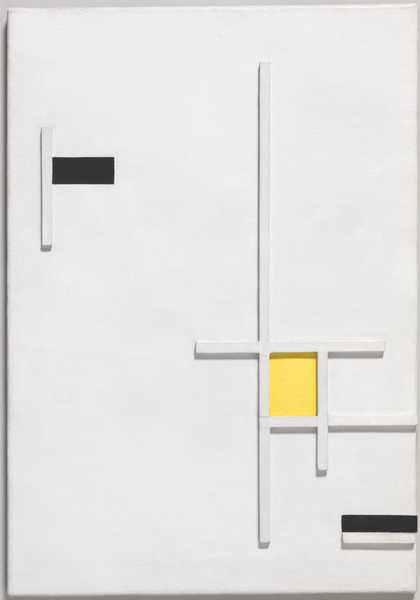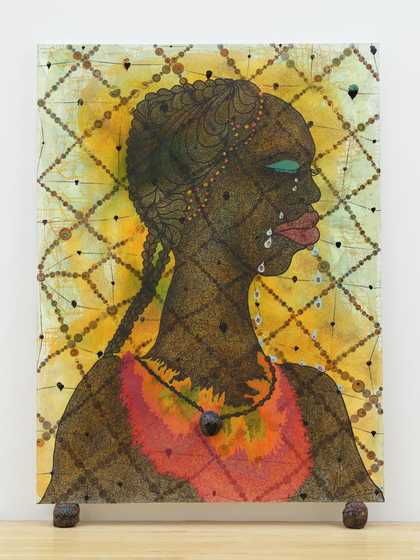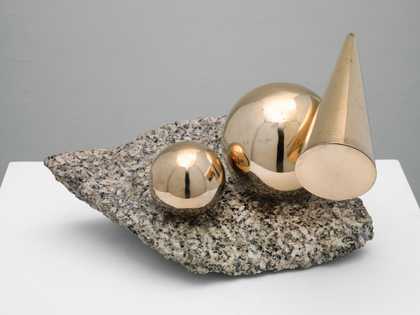Press play and discover the story behind White and Yellow by Marlow Moss. Hear a detailed description of the artwork, including its colours, materials and textures.
Marlow Moss White and Yellow 1935
This is an audio description of the painting White and Yellow by artist Marlow Moss, made in 1935.
Moss produced abstract artworks based on mathematical systems and proportions.
This work measures just over 62 centimetres high and 40 wide. It is a collage using oil paint, string and cut out canvas. It is mounted on a canvas which stands about a centimetre proud of a roughly-painted white wooden frame. This canvas hangs inside a deep white box-frame, which is glazed. The work is mostly an off-white colour, with one small rectangle of yellow in the bottom left corner.
White and Yellow is one of the earliest works Moss made with string and canvas. The work is strikingly geometrical. All angles are right angles, and lines and elements within the design are parallel with the edges of the base canvas, and with each other.
The base canvas is painted white. A heavily textured piece of canvas is cut like an uppercase letter ‘T’ laid on its side. It is also painted white, and is overlaid onto the base. This shape covers the right-hand side of the canvas, from top to bottom, extending over a quarter of the width. About halfway down it extends out to the left, across the full width of the main canvas. It leaves a wide strip of underlying canvas exposed, across the top and bottom of the work.
This overlaid piece is dissected vertically and horizontally by lengths of wire-like string, less than a millimetre wide. The string has a darker colour and slight metallic sheen. One string runs vertically from top to bottom, a few centimetres in from the left edge. It cuts cleanly through the overlaid piece.
Further strings sub-divide the composition into rectangles and squares. A few centimetres to the right, a second string runs in parallel, also slicing through the overlay. But before it reaches the bottom of the composition it changes direction, turning horizontally to the right. It cuts through the overlay. A third length of string runs horizontally across the top, a few centimetres below the edge of the main canvas. However, this time, it disappears behind the overlaid shape.
A fourth line outlines the vertical inner edge of the 'T' shaped overlay. It disappears where the shape extends out to the left, and reappears towards the bottom of the canvas. Finally, a short line runs horizontally from the left. It crosses the first vertical string and ends at the second, framing the top of the painted yellow rectangle in the lower left section.
On the bottom right, under the overhang of the canvas, are small markings in amber paint.
While the layout has a mathematical precision, the three-dimensional nature of the work changes with light and viewing position. The dark strings can suggest either an outline of a shape, an edge or shadow. It has been suggested that Moss developed this relief technique to achieve a linear composition without having to use any black. Moss felt that black hampered the expression of light. And while this composition is a construction of lines, none of them are drawn or painted. All are created by an interplay between cut and layered surfaces, textures, raised strings and cast shadows.
Writing about their work in 1949, Moss said it was 'constructed on a very simple principle – a geometrical figure – sometimes broken, sometimes cut, sometimes divided, sometimes sub-divided – until the relation of the lines to each other produce an aesthetic emotion.'
Moss suggests that the works can to a certain extent, be compared to music: 'If one considers the lines in these drawings as sounds (note or chord progressions) and the geometrical figure as the musical key… Music is the ‘art of combining sounds with a view to beauty of form’; this work aims at ‘beauty of form’ by coordinating form and line on the plane.'
Moss lived and worked between Paris and Cornwall. An influential figure for a younger generation of British artists, Moss’ contribution to mid-twentieth century abstract art has only recently gained wider recognition.
This audio description was written by VocalEyes describer Clare Le May and recorded by Chandrika Chevli.




